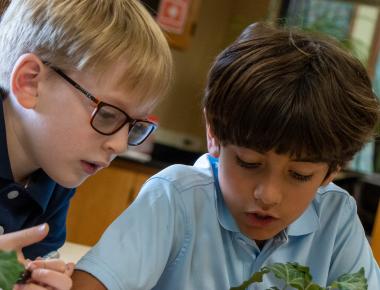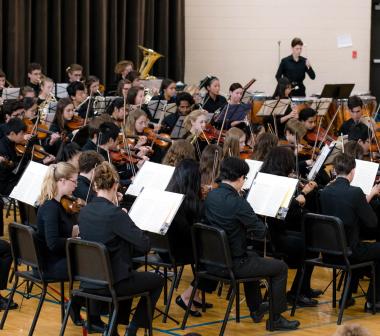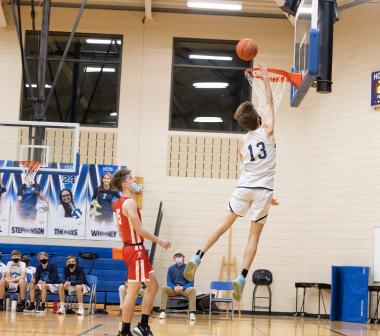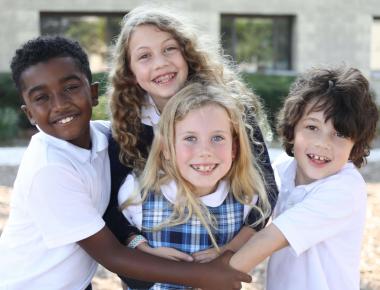Lower School
Grade 1
Students in first grade participate in assemblies, classroom meetings, and multi-grade buddies. Our students and teachers come together to build a community through these meaningful collaborations. Reading and writing skills are developed through our exceptional language arts instruction. Through our math program students are given the tools to read, write, and discuss mathematics. Science, Art, Music, Spanish and PE continue to be taught by specialized teachers. The scientific method is introduced through hands-on experiments. Every student begins piano lessons, while continuing general music classes and choir.
First Grade Curriculum:
Language Arts
The Logic of English program teaches spelling, phonics, and reading words and texts by grouping together similar word and sound patterns. Letter formation and spacing, grammar skills, punctuation, capitalization, compound words and contractions are introduced and practiced. The students work on writing the four different types of sentences, declarative, interrogative, exclamatory, and imperative in daily writing. Students begin writing personal narratives, poetry, fiction, nonfiction and procedural essays.
Reading skills are further developed by using decodable texts and connecting reading with their phonogram knowledge. Reading comprehension skills allow students to spend time reading authentic texts that interest them on a daily basis. Students learn reading strategies and embrace opportunities to talk about literature. The ultimate goal of a reading inquiry is to develop life-long passionate readers who can read a variety of texts that have increasing levels of complexity.
Math
The Singapore Math program allows students to experience concepts through the CPA (Concrete, Pictorial, Abstract) progression. Concepts presented in First Grade include: reading and writing numbers to 120, counting by 2s, 3s, 5s and 10s to 100, and adding and subtracting two-digit numbers to 100. Other concepts include time, money, basic fractions, and multiplication and division of 2s, 5s and 10s. Word problems and methods of solving them are an integral part of the program.
History and Geography
The first grade curriculum includes World and American History. Geography is embedded throughout the various units of study. World studies begin with learning about the different landforms around the world and progressing through early civilizations including Mesopotamia, Egypt, India, and China. Students focus their inquiry on the major inventions from each of the ancient civilizations. Student learning is guided by student inquiry and PYP Units of Study.
Art
This course consists primarily of studio work, creating 2D and 3D artworks, with an emphasis on learning materials and techniques. The history of art and how to discuss it plays a role in the class as students are encouraged to reflect on their own and others’ artwork. While reviewing the elements and principles of art, students also receive assignments that focus on problem solving and open-ended creative thinking. Projects for this year include creating an all-over surface print, designing a book cover, a mixed media painting, and a ceramics unit that details different methods of construction.
Music
Students begin a broad introduction to the Baroque and Classical periods in music history, studying composers and listening to many musical examples. In first grade, students begin weekly piano lessons, applying and reinforcing music concepts learned in classroom music including rhythm, pitch, and spatial relationships. Students learn to set goals and develop beginning performance skills as they prepare for their first piano recital. Singing in a group and alone, through movement exploration, and playing instruments, students establish critical musical experiences that lead to a meaningful understanding of beginning musical notation. Unison choral singing in choir also prepares students to work collectively to perform in two concerts, and for assemblies on Grandparents Day, for Fine Arts Week, and during other special events. Students enjoy being introduced to the instruments of the orchestra as they hear and learn about the four instrument families and are exposed to a variety of orchestral music.
Science
Students in first grade practice the process of science with an emphasis on predicting and recording their observations. Students utilize the campus environment to study aquatic habitats and create desktop ponds to observe the interactions of fish, insect larvae, and plants. Additionally, students explore the solar system, particularly comparing earth to sun, learning about the earth’s rotation, revolution and tilt. Students investigate food groups and the importance of good nutrition.
Spanish
The goal of the Spanish program is communicative competence in speaking, listening, reading, and writing. Emphasis on building vocabulary through children’s poetry, songs, role playing, games, and stories addresses topics such as greetings, expressions of emotions, people and things in the classroom, numbers, colors, days of the week, body parts, animals, states of being, family, weather, months, clothes, rooms in the school, traffic safety, transportation, places to go, and summer activities. Throughout the year students experience the traditions of various cultures and regions of the Spanish speaking world through units on Cinco de Mayo, Día de los Muertos, and Christmas celebrations.
Physical Education
The program emphasizes physical skills that can be applied in multiple sports situations. Through games and drills, students learn basic skill development, fine and gross motor movements, spatial awareness and basic strategy. They develop confidence and motivation to participate in organized and individual physical activities and learn leadership, teamwork, and good sportsmanship while emphasizing lifelong fitness.
Our Curriculum in Action:

























